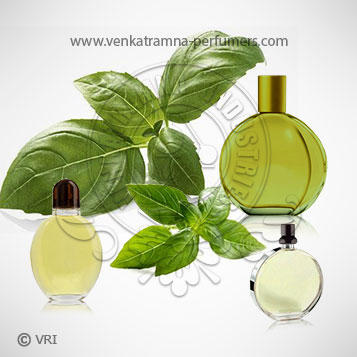
| Botanical Name | Ocimum basilicum |
| Common Name | Sweet basil, common basi, Winter cherry, Indian ginseng, Ajagandha, Ayamodakam, Kanaje, Samm Al Ferakh. |
| Country of Origin | Canada, New Zealand |
| Solubility | Insoluble in water, soluble in alcohol and oils |
| Specific Gravity | 0.95°C to 0.97°C |
| Optical Rotation | -12 |
| Refrective Index | 1.5200°C |
| PlantPart | Leaves |
| Bland With | Bergamot, clove bud, clary sage, geranium, lemon, lime, hyssop, eucalyptus, juniper, neroli, rosemary, marjoram, melissa and lavender. |
| CAS No | 8015-73-4 |
| Flash Point | 89°C |
| Extraction Method | Hydro Distillation Method |
Basil oil is obtained through hydro distillation from fresh plant material from Ocimum Basillicum. The Basil oil is thin transparent fluid with light yellow to yellow-green color with aroma characteristic of Basil. A native of Africa and Seychelles, it is grown as popular culinary herb and has small white flowers. The essence is distilled from leaves and has light greenish yellow with sweet green overtones. The Basil oil derived is known for intensely fresh, sweet-spicy and vibrant aroma.
Mediterranean cuisine seems unthinkable without Basil, but apparently the ancients did not share our modern passion for this herb. Dioscorides and Galen both did not think it fit for human consumption. In Egypt the fresh leaves were scattered on fresh graves and in India some leaves are placed on the bodies of the dead to serve as a key to heaven's gates. In Tudor times it served as a farewell present, small pots being presented to visitors upon departure. In Crete it served as a symbol for "love washed with tears" while in Italy, it had a more lurid connotation. Here it was known as "Kiss-me Nicholas" and daring young girls would decorate their hair with it, wafting a fragrant hint to passing Nicks. In India, the local Basil known as Tulsi, was considered a most holy plant. It is sacred to Vishnu and Krishna as Vishnu's wife Lakshmi transformed into the holy Basil, Tulasi. Holy Basil is greatly honoured and often grown in temple gardens and near dwellings. Sacred jewellery is fashioned from the roots.
Color : Golden yellow with some green tone,
Aroma : Basil Oil is very famous for its sweet flavor and aroma
Linalool, (-)-bornyl acetate, eugenol and eucalyptol.
It is used for inhalation , in baths and for massages. Having both cold & hot qualities, when it is used in bath or is smoothed over the body, it has invigorating effect that is very beneficial for sluggish skin & pepping up circulation. When combined with other oils like Thyme, it also acts as powerful antiseptic. It also finds application for the treatment of migraines, arthritis and paralytic conditions. It is also used to fight intestinal parasites and stimulate liver & pancreas.